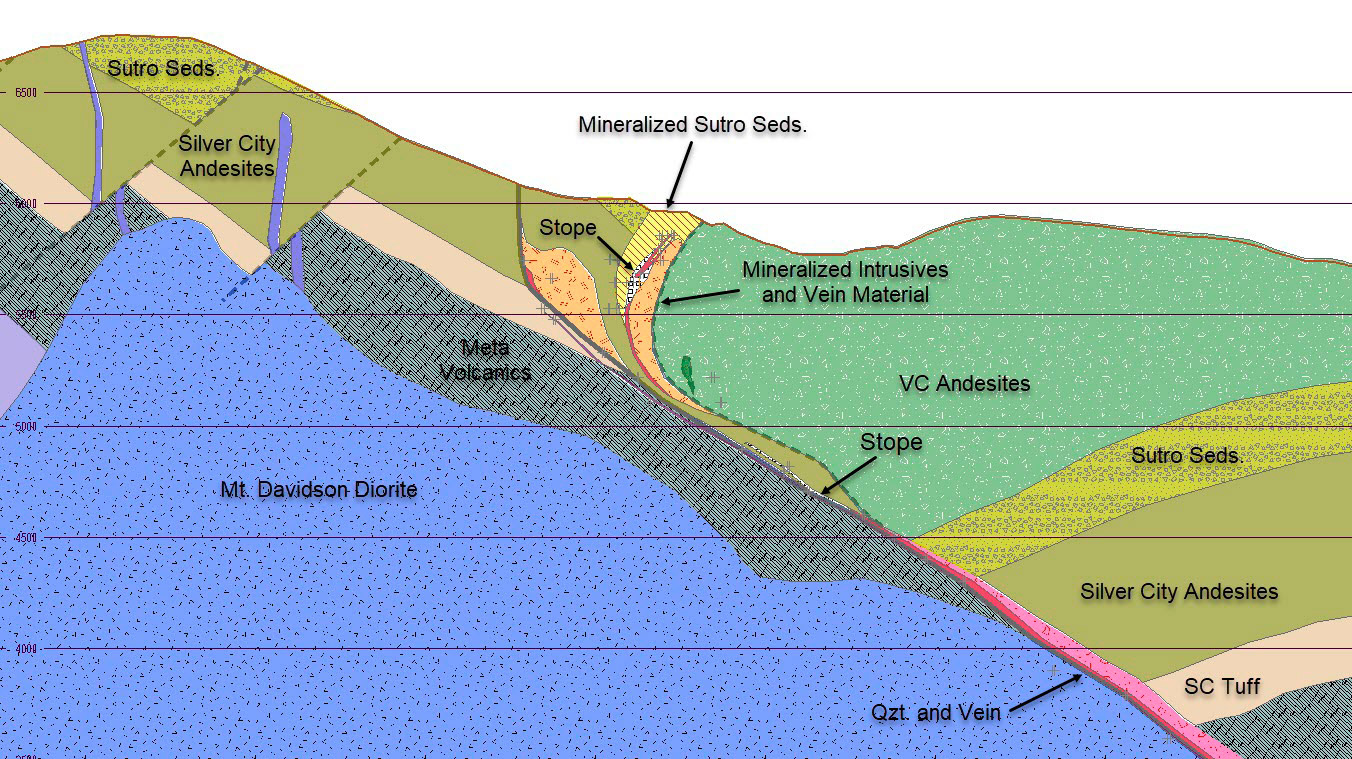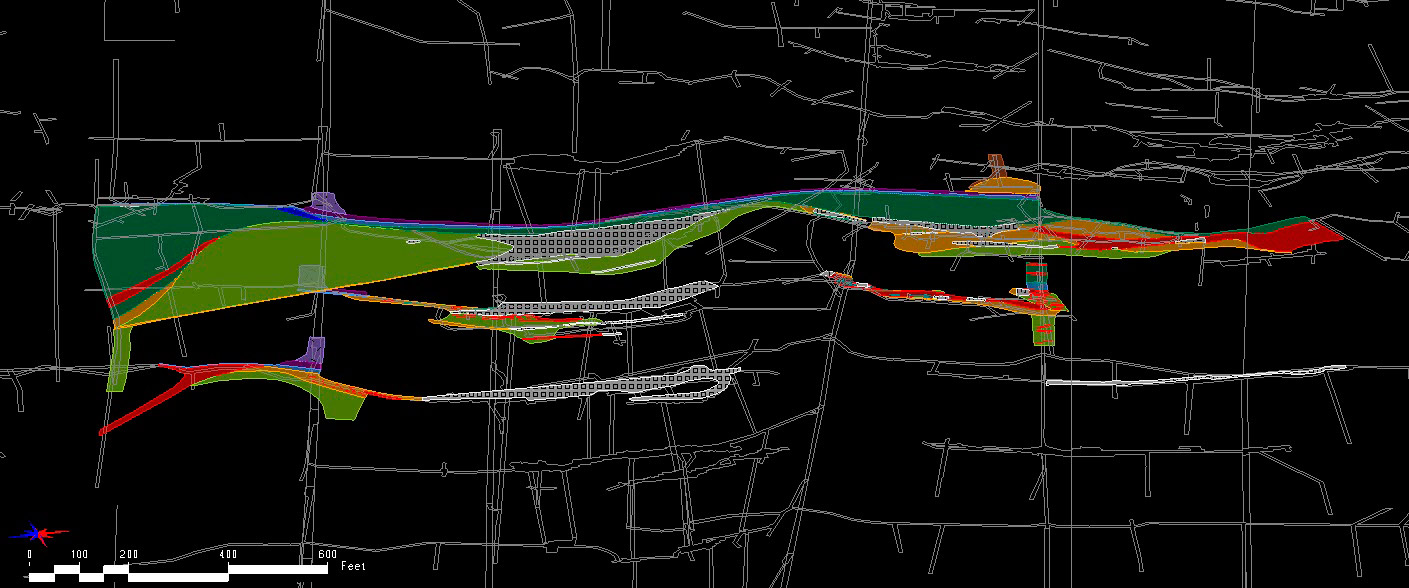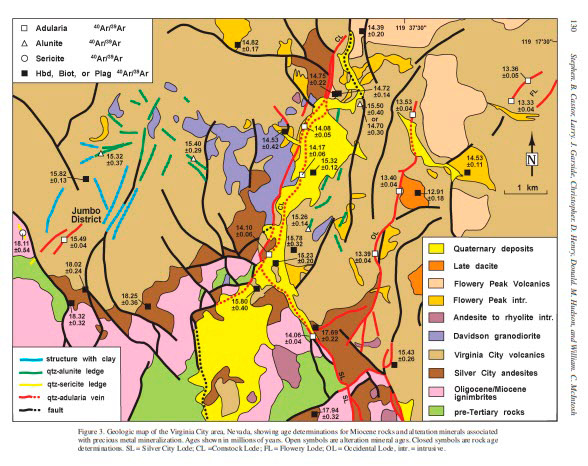GEOLOGY
– Tonogold believes that a substantial mineable resource of gold and silver remains in the Comstock Mining District.
Epithermal mineralization and intermediate volcanism in the Virginia City area, Nevada.
Stephen B. Castor, * Larry J. Garside and Christopher D. Henry.
Nevada Bureau of Mines and Geology / 178, University of Nevada, Reno NV 89557.
Donald M. Hudson.
1540 Van Petten St. Reno NV 89503.
William C. McIntosh.
New Mexico Bureau of Mines and Mineral Resources, Socorro NM 87801.
Stephen B. Castor, * Larry J. Garside and Christopher D. Henry.
Nevada Bureau of Mines and Geology / 178, University of Nevada, Reno NV 89557.
Donald M. Hudson.
1540 Van Petten St. Reno NV 89503.
William C. McIntosh.
New Mexico Bureau of Mines and Mineral Resources, Socorro NM 87801.
The oldest rocks within the district are present to the west of the southeast-dipping Comstock Fault and include the Triassic to Jurassic Gardnerville Formation, meta-igneous rocks of inferred Jurassic age, and Cretaceous granitic rocks of the Sierra Nevada Batholith. These older rocks are successively overlain by Oligocene rhyolite ash-flow tuffs and predominantly andesitic flows and intrusions of the Miocene Silver City and Virginia City volcanic suites. Miocene-age Davidson diorite is most commonly present west of the Comstock Fault in the northern part of the district but has also extensively intruded the Virginia City suite of volcanics, older rocks in the footwall, and the Comstock Lode itself. The andesitic flows of the Kate Peak Formation, which comprises the upper member of the Virginia City volcanic suite, are present to the east, adjacent to the Occidental-Brunswick Lode.
The key element of the district from an economic standpoint is the complex system of faults that host mineralization. Most of the structures are moderately dipping (down-to-the-east) normal faults with displacements of up to 300 meters. The Comstock Fault, which is the most significant structure in the district, forms a mineralized zone which is locally up to 245 meters wide that extends more than 5,400 meters along strike through Virginia City in the north and Silver City to the south. Both the Comstock and Silver City lodes are hosted in this continuous zone. Mineralization has been detected to depths of more than 3,000 feet on the Comstock Lode proper.

Age dating suggests that epithermal, low-sulfidation mineralization occurred district-wide from the circulation of near neutral- to slightly alkaline fluids during the latter stages of Miocene volcanism about 14 million years ago. Gold and silver mineralization in the district has been found within quartz and calcite-bearing veins, stockworks, and breccias. The principal ore minerals include acanthite, electrum, native gold and silver, and polybasite.

KEY GEOLOGICAL STUDIES OF COMSTOCK
- The Comstock Lode: Its Character and the Probable Mode of Its Continuance in Depth by Ferdinand Baron von Richthofen (The Red Baron’s uncle!), published in 1866.
- Report of the Geological Exploration of the Fortieth Parallel, Vol. III, Mining Industry by James D. Hague and Clarence King, published in 1870.
- The Comstock Lode, Its Formation and History by John Adams Church, published in 1878.
- Geology of the Comstock Lode and the Washoe District by George F. Becker, published in 1882.
- Chronology of Miocene hydrothermal and igneous events in the western Virginia Range, Washoe, Storey, and Lyon counties, Nevada by Peter Vikre, published in Economic Geology in 1988.
- Epithermal Alteration and Mineralization in the Comstock District, Nevada, by Donald M. Hudson, published in Economic Geology in 2003.



